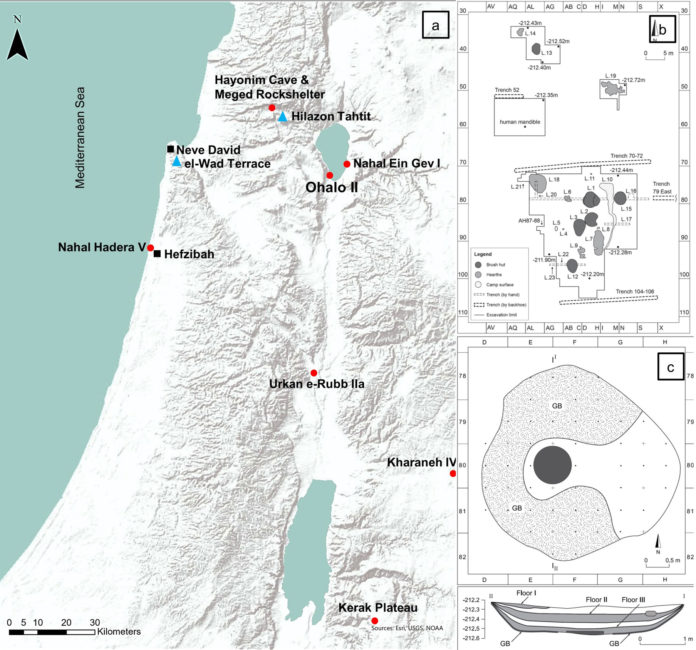A shift from the hunting of large animals (“higher-ranked”) to hunting smaller, more challenging to attain prey (“lower-ranked”) is the characteristic of the final Pleistocene zooarchaeological record in the Mediterranean southern Levant. The number of fallow deer, a common prey species, decreased in favor of smaller ungulates (predominantly gazelle) and a variety of small prey. This is particularly evident through the Epipalaeolithic period in the Mediterranean Levant.
Population growth and over-exploitation of resources in the Levant is argued to have driven foragers to broaden their dietary range and procure a wider variety of plant and animal resources, including small carnivores, birds, fish, mollusks, and wild cereals and legumes. The diversification and intensification in the subsistence base of Late Pleistocene hunter-gatherers had coined the Broad Spectrum Revolution.
The submerged site of Ohalo II was occupied during the Last Glacial Maximum (LGM), between 23,500–22,500 cal BP, bridging the Upper Paleolithic/Epipaleolithic transition in the southern Levant. The site is known for the excellent preservation of its brush huts and botanical remains.
A new study published in the open-access journal PLOS ONE by Tikvah Steiner of the Hebrew University of Jerusalem and colleagues suggested that Ohalo II is an example of diverse prey choice motivated by abundance rather than stress 23,000-year-old fisher-hunter-gatherers camp.
“The excellent preservation of faunal and botanical remains at the water-logged site of Ohalo II provides a unique opportunity for a detailed analysis of subsistence strategies during the Last Glacial Maximum (LGM), ca. 23,000 cal BP, a period encompassing the shift from the Upper Paleolithic to the Epipaleolithic.” Study quotes
Researchers focused on a quantitative, qualitative, and spatial investigation of the more than 20,000 faunal remains. Identification of faunal remains to the most detailed level possible, combined with analysis of skeletal element frequencies, allowed reconstruction of the desired prey profile, highlighting the importance of small, suitable prey compared to the giant game.
An increase in dietary breadth is explained by two opposing approaches, one suggesting it was the outcome of resource depletion, the other suggesting the impact of resource abundance.
Optimal Foraging Theory (OFT) is a framework whereby hunter-gatherers were theoretically forced to adapt to resource depression and the declining availability of preferred food species by broadening their resource base.
Niche Construction Theory (NCT) posits that resource intensification results from active environmental engagement rather than mainly reaction to external conditions. Within this theory, populations are drawn to resource abundance and stability zones. They utilize a wide range (or a broad spectrum) of available resources to support the population over time.
Climatic oscillations during the Last Glacial Maximum (LGM) had minimal effects on the Upper Jordan Valley, specifically in the vicinity of Ohalo II, enabling the Ohalo II people to utilize a broad ecological niche comprised of varied edible plants, mammals, reptiles, birds, and fish.
Broad-spectrum foraging is not necessarily an indicator of stress in this case; rather, it may be an indicator of plenty. Despite hunting prime adult ungulates, a wide range of prey was exploited. The extreme fragmentation is not necessarily an indicator of subsistence stress; even in settings with abundant resources, carcasses could be fully utilized down to the marrow.
For example, tortoises were seemingly selected for specific body sizes, suggesting that their shells, not their meat, were the primary target. Hare and fox were possibly hunted for their pelts.
The study concludes that “The Brush Hut 1 evidence points to a case of resource abundance through careful niche selection where the exploitation of a broad array of predictable resources as possible. This best mirrors the NCT model in many ways, though certainly preservation plays an important role in recognizing the varied resources exploited in the past. Finally, Ohalo II reflects a true broad-spectrum economy during the LGM at the very beginning of the Epipaleolithic period.”
Journal Reference
- Tikvah Steiner, Rebecca Biton, Dani Nadel, Florent Rivals, Rivka Rabinovich. Abundance or stress? Faunal exploitation patterns and subsistence strategies: The case study of Brush Hut 1 at Ohalo II, a submerged 23,000-year-old camp in the Sea of Galilee, Israel. PLOS ONE, 2022; 17 (1): e0262434 DOI: 10.1371/journal.pone.0262434
